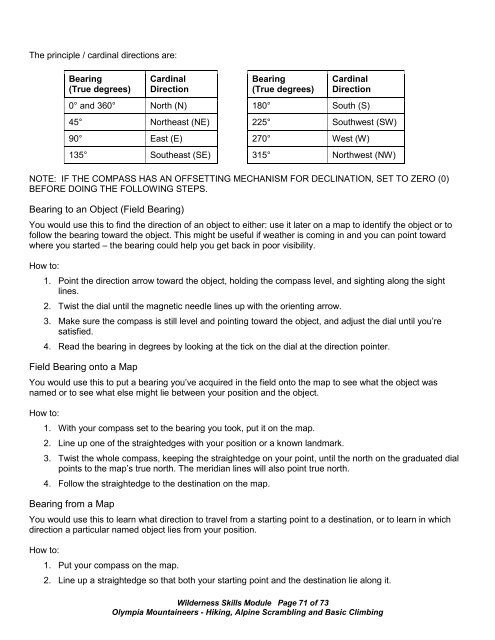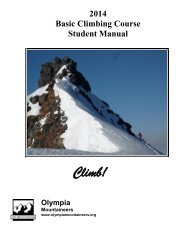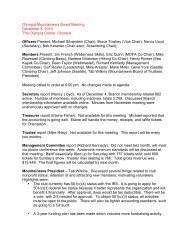Wilderness Skills - Olympia Mountaineers
Wilderness Skills - Olympia Mountaineers
Wilderness Skills - Olympia Mountaineers
Create successful ePaper yourself
Turn your PDF publications into a flip-book with our unique Google optimized e-Paper software.
The principle / cardinal directions are:<br />
Bearing<br />
(True degrees)<br />
Cardinal<br />
Direction<br />
Bearing<br />
(True degrees)<br />
Cardinal<br />
Direction<br />
0° and 360° North (N) 180° South (S)<br />
45° Northeast (NE) 225° Southwest (SW)<br />
90° East (E) 270° West (W)<br />
135° Southeast (SE) 315° Northwest (NW)<br />
NOTE: IF THE COMPASS HAS AN OFFSETTING MECHANISM FOR DECLINATION, SET TO ZERO (0)<br />
BEFORE DOING THE FOLLOWING STEPS.<br />
Bearing to an Object (Field Bearing)<br />
You would use this to find the direction of an object to either: use it later on a map to identify the object or to<br />
follow the bearing toward the object. This might be useful if weather is coming in and you can point toward<br />
where you started – the bearing could help you get back in poor visibility.<br />
How to:<br />
1. Point the direction arrow toward the object, holding the compass level, and sighting along the sight<br />
lines.<br />
2. Twist the dial until the magnetic needle lines up with the orienting arrow.<br />
3. Make sure the compass is still level and pointing toward the object, and adjust the dial until you’re<br />
satisfied.<br />
4. Read the bearing in degrees by looking at the tick on the dial at the direction pointer.<br />
Field Bearing onto a Map<br />
You would use this to put a bearing you’ve acquired in the field onto the map to see what the object was<br />
named or to see what else might lie between your position and the object.<br />
How to:<br />
1. With your compass set to the bearing you took, put it on the map.<br />
2. Line up one of the straightedges with your position or a known landmark.<br />
3. Twist the whole compass, keeping the straightedge on your point, until the north on the graduated dial<br />
points to the map’s true north. The meridian lines will also point true north.<br />
4. Follow the straightedge to the destination on the map.<br />
Bearing from a Map<br />
You would use this to learn what direction to travel from a starting point to a destination, or to learn in which<br />
direction a particular named object lies from your position.<br />
How to:<br />
1. Put your compass on the map.<br />
2. Line up a straightedge so that both your starting point and the destination lie along it.<br />
<strong>Wilderness</strong> <strong>Skills</strong> Module Page 71 of 73<br />
<strong>Olympia</strong> <strong>Mountaineers</strong> - Hiking, Alpine Scrambling and Basic Climbing




